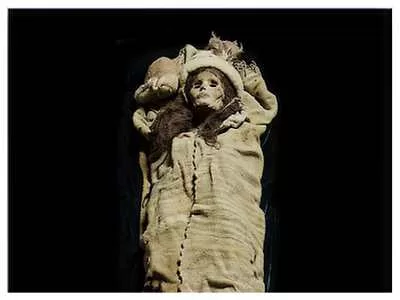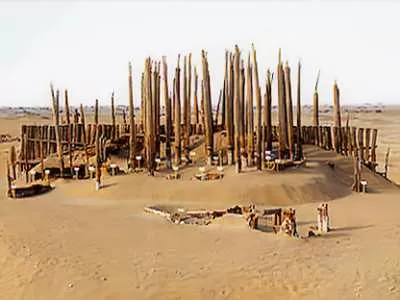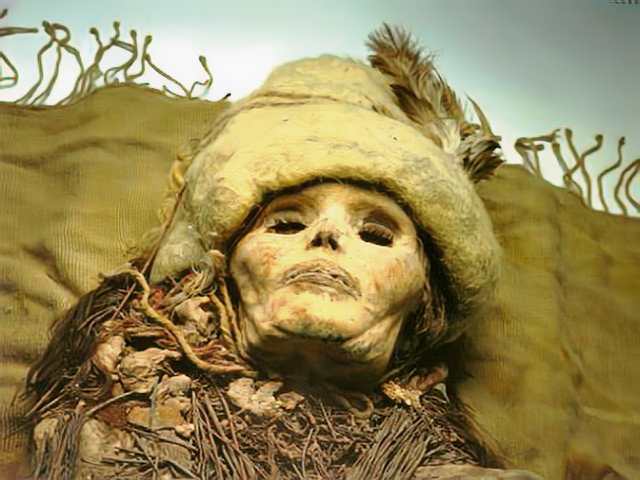Ancient Mysteries
In the heart of a formidable desert north of Tibet, Chinese archaeologists have unveiled a captivating cemetery that holds the remains of individuals who perished almost 4,000 years ago. Despite the arid conditions of the Tarim Basin in China’s northwest autonomous region of Xinjiang, the bodies have been remarkably preserved. This extraordinary burial ground, known as Small River Cemetery No. 5, harbors enigmas that challenge our understanding of ancient civilizations.
Intriguingly, the inhabitants of this cemetery possess distinct European features, with brown hair and long noses, a stark contrast to their geographical location. Their resting places are unconventional as well, nestled in upside-down boats rather than traditional graves. Instead of typical tombstones, the cemetery is adorned with a striking array of phallic symbols, hinting at a profound interest in procreation or fertility rituals.

The origin and identity of these long-vanished people remain elusive, shrouded in mystery. Small River Cemetery No. 5, situated near a desiccated riverbed in the challenging terrain of the Tarim Basin, has become a focal point for unraveling clues about their ancestry, way of life, and even the language they spoke.
Despite being a region now occupied by the Turkish-speaking Uighurs and Han settlers from China, ancient tensions have resurfaced. The 200 or so mummies discovered in the Tarim Basin, displaying Western characteristics, have become pawns in ethnic disputes between the Uighurs and the Han. The DNA analysis of these mummies reveals a complex ancestry, with both European and Siberian genetic markers, suggesting an origin outside China.
The Small River Cemetery mummies, dating back 3,980 years, are the oldest found in the Tarim Basin. Genetic studies conducted by a Chinese team led by Hui Zhou of Jilin University indicate mixed ancestry, with Y chromosomes associated with Eastern Europe, Central Asia, and Siberia, rarely found in China. The mitochondrial DNA further suggests connections to Siberia and Europe.
The cemetery, rediscovered in 1934 by Swedish archaeologist Folke Bergman, was later excavated from 2003 to 2005 by Chinese archaeologists. Their findings, translated and summarized by Victor H. Mair of the University of Pennsylvania, depict a burial site replete with symbolism. Massive poles, resembling oars, were discovered alongside boats adorned with cowhide. The bodies inside these vessels were clad in well-preserved attire, including feathered felt caps and Tyrolean-style woolen garments.

Intriguingly, the boats containing women were accompanied by life-size wooden phalluses, while poles with bladelike tops were positioned above men’s boats, symbolizing sexual duality. Dr. Mair notes that the entire cemetery exudes blatant sexual symbolism, underscoring the community’s profound reverence for procreation.
This ancient society’s fixation on fertility might be rooted in the harsh conditions they faced, leading to a high infant mortality rate and an essential need for procreation. The absence of known settlements near the cemetery implies that these people likely lived elsewhere, reaching the burial site by boat.
Despite the desolate environment, the Small River Cemetery people showcased a rich cultural tapestry. The absence of woodworking tools at the site suggests that the poles were carved off-site. The language spoken by these enigmatic people remains unknown, but Dr. Mair proposes Tokharian, an ancient Indo-European language, as a possibility.
As the world awaits further revelations from ongoing research, an exhibition of the Tarim Basin mummies is set to open at the Bowers Museum in Santa Ana, Calif., on March 27. This unprecedented showcase promises to unveil more secrets hidden in the sandy embrace of the ancient Small River Cemetery No. 5.

